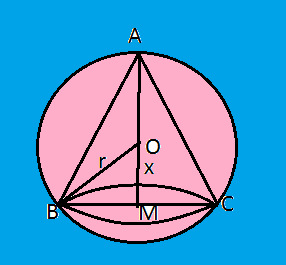Question: Prove that the volume of the largest cone that can be inscribed in a sphere of radius R is 8/27 of the volume of the sphere.
Solution: Consider ![]() be the centre and
be the centre and ![]() be the radius of the given sphere,
be the radius of the given sphere, ![]()

In ΔOBM, using pythagoras theorem
![]()
![]()
![]()
![]()
BM is the radius of cone
Volume of cone ![]()
![]()
![]()
![]()
Differentiating with respect to x
![]()
![]()
![]()
![]() —(ii)
—(ii)
For max and minima ![]()
![]()
Hence ![]() or
or ![]()
![]() or
or ![]()
![]() Not possible
Not possible
Agian differentiate with respect to x of eq (ii)
![]()
![]()
![]()
At ![]()
![]()
![]()
Hence volume of cone is max when ![]()
Now From eq (i)
![]()
![]()
![]()
Volume of cone ![]() volume of sphere
volume of sphere
https://gmath.in/a-wire-of-length-28-m-is-to-be-cut-into-two-pieces/